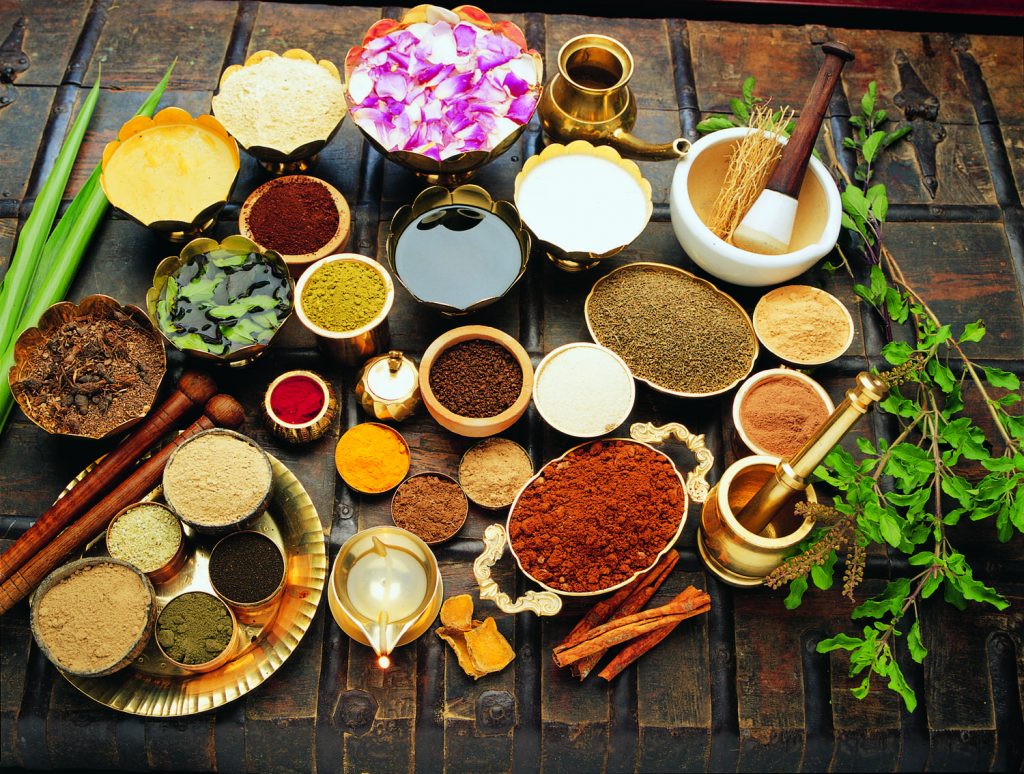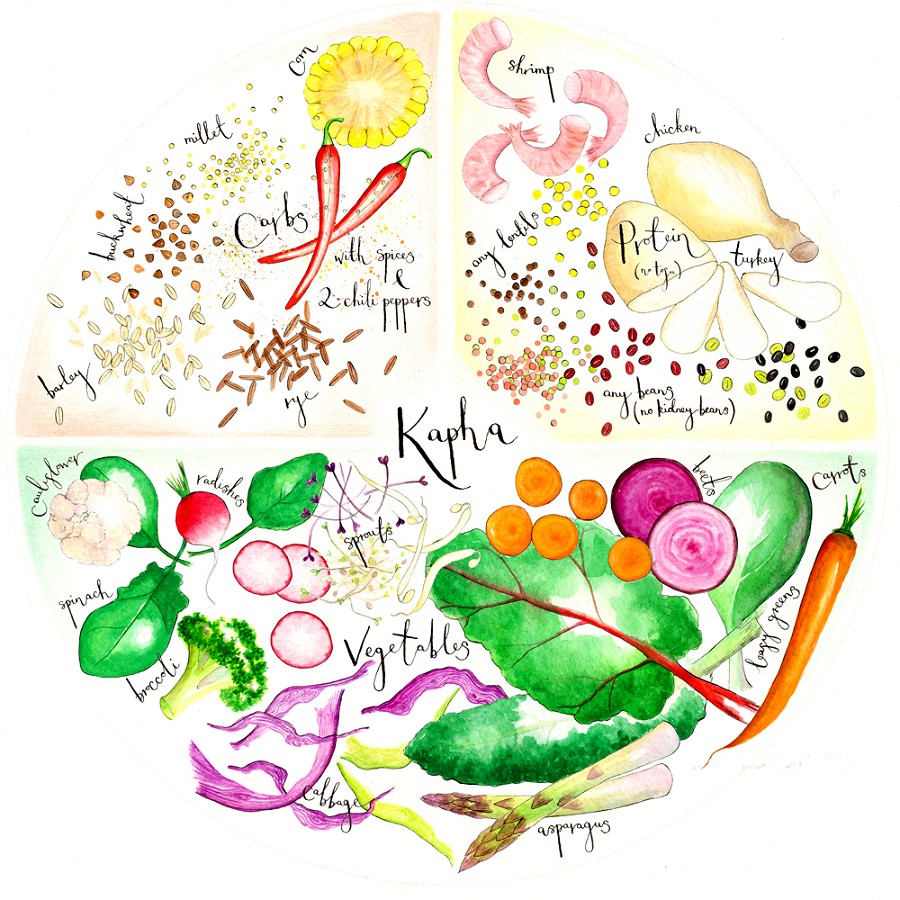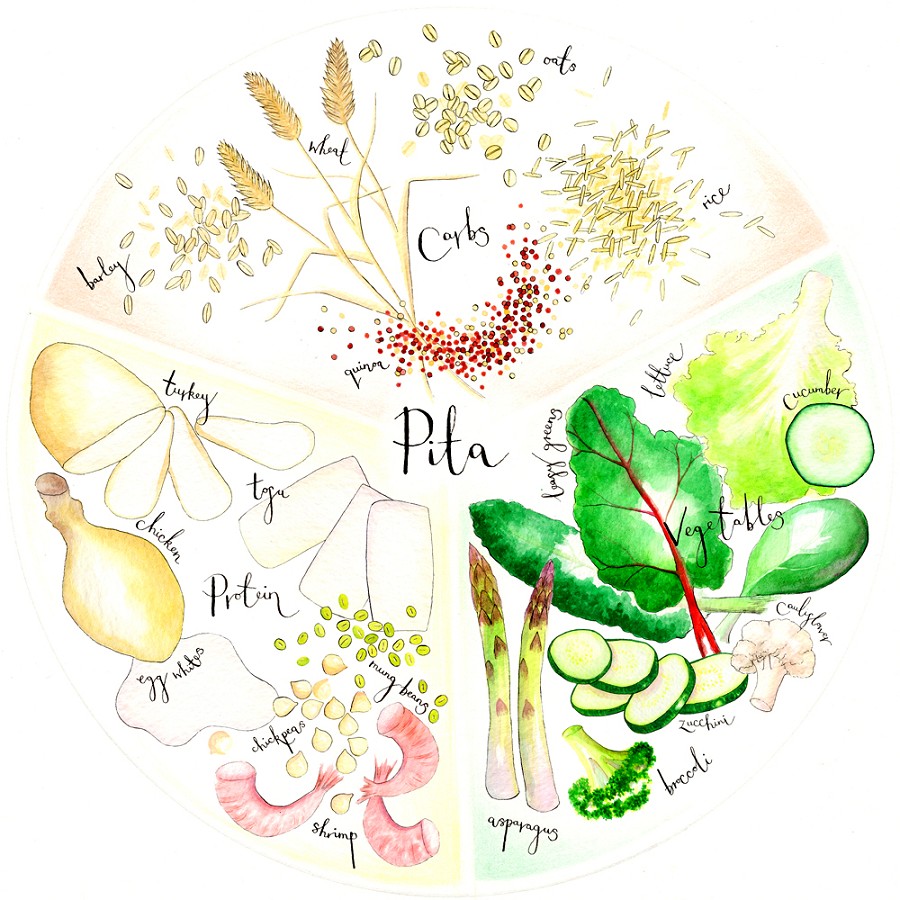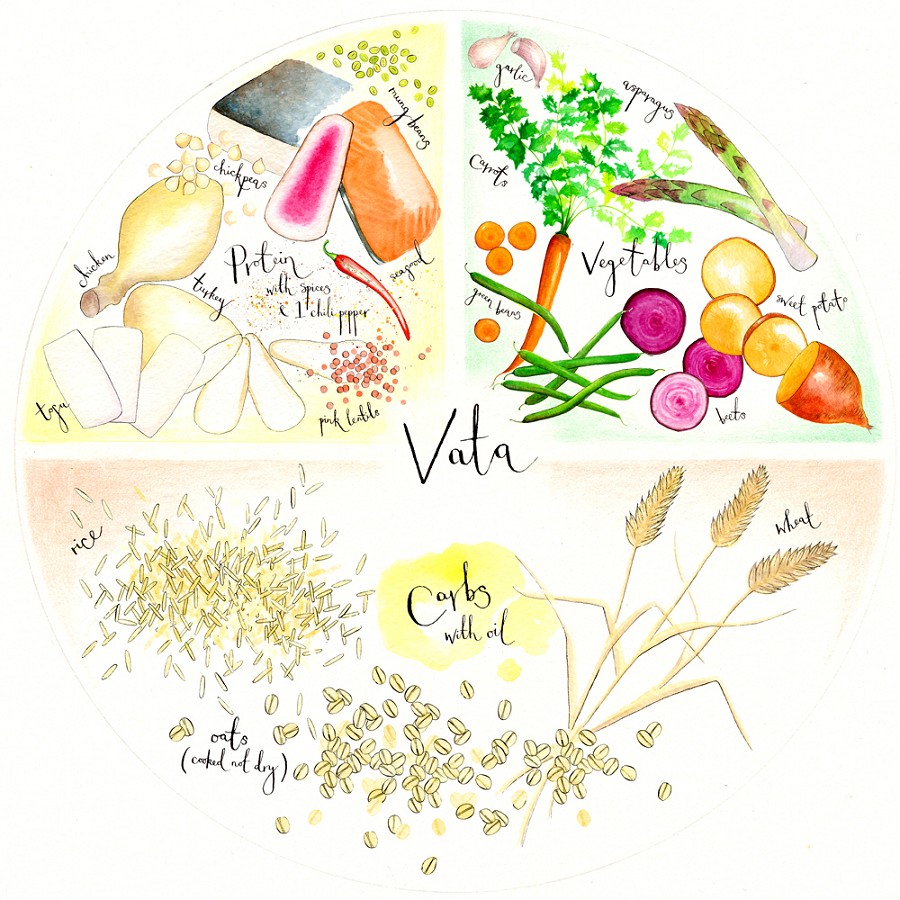Have you ever heard of Ayurveda? If you have, that’s truly amazing! If you have not, it is time for you to learn about it! In any case, there is no harm in learning something new, especially when it’s deliciously beneficial to you. In precise, Ayurveda is the ancient medical system of India that efficiently solves our modern-day health problems. It believes that all good health starts with the wise food choices which lead to proper metabolism of food.

Food is more than just food. It is, in fact, influences your mind, body and soul in a truly powerful way. There is a writing of ancient texts of Ayurveda that says “food is medicine when consumed properly.” If you consume food which uniquely suits your physiology and follow a healthy lifestyle, your body will reap the benefits in many aspects. The holistic approach to health allows you to be the happiest person with least amount of effort. Every day will feel like you’re walking in sunshine – you are happier and healthier regardless of your age. And this is the spirit by which the Ayurveda diet was conceived upon.

How do you know what exactly is the right food for you? According to the principles of Ayurveda, each of us has a unique mix of three body and mind principles, which creates our mental, emotional and physical characteristics. These principles are known as dosha, which is a reflection of the qualities of nature. To find an accurate examination of your dosha, an ayurvedic physican will need to get into details of your medical history and physical condition. However, there are a few quick quizzes out there which will provide you a tremendous insight of your dominant dosha. Once you have identified them, you may want to pacify that dosha and embrace it!
Kapha

First and foremost, a typical kapha has the most extensive body types among the three. Their physical appearance may include wide hips or shoulders. They have long, thick, wavy hair and is physically fit in behalf of their excellent physical stamina. Mentally, kapha types may not be the fastest learner, but they have a great ability to remember memories. They are often the “rock” in a relationship because of their loyal, stable and reliable nature.
How kapha eats has a profound impact on the degree of success. It is essential for them to eat in a peaceful environment to reduce the potential of emotional eating and overeating, which often afflict kapha.
It is prudent to eat on a consistent schedule and to chew a slice of fresh ginger with a pinch of sea salt, a few drops of lime juice and 1/4 tsp of honey to kindle their sluggish digestive system. Although it may be impossible to avoid all kapha aggravating foods, serving the food in a small quantity with warm and heating herbs can minimise the effect.
Kapha diet consists of a balanced diet of warm freshly cooked whole foods that are light, dry, well spiced, and easy to digest. These foods relieve kapha’s moisture level, and digestion and elimination system. An ideal diet can be illustrated as an appropriate minimalistic approach with smaller portions, little to no snacking, fewer sweets and an abundance of fresh fruits and vegetable.
It is crucial to find an appropriately satisfying diet to achieve success. Kapha is cool, heavy, oily, and smooth, so eating foods that are light, warm, dry, and rough can help to neutralize the balance excess kapha.

Understanding kapha tastes will help in navigating the diet. In a nutshell, kapha is pacified by the pungent, bitter, and astringent flavours and aggravated by the sweet, sour, and salty tastes. Dry, rough pungent taste found in most spices, such as cardamom, cloves, and cumin are beneficial in a way that it stimulates digestion and liquefies secretions.
Similarly, bitter taste which predominates bitter greens such as eggplants and burdock roots cools down and supports metabolism. Besides, astringent taste helps in toning body tissues and fluids. Look out for legumes, grains and baked goods which is rich in astringency.
Accordingly, kapha should minimize its intake on sweet, salty and sour food. It is only fair to eliminating refined sugar and relying on naturally sugary foods like fruits, grains, and nuts to avoid their tendency toward obesity and excess sleep.
Although lemon juice is beneficial in their diet, other moistening and oily sour taste from sour cream, cheese and vinegar may retain water and heaviness in the eyes. Salt or sodium may also trigger emotional greediness for food and simultaneously, impede the sense of organs.
All in all, breakfast is an optional option for kapha, and a light breakfast of fresh fruits or tea will suffice. In a weight loss case, a more substantial healthy breakfast is favored in the place of dinner. For lunch, the portion should revolve around steamed or sautéed vegetables, complemented with appropriate beans, grains, and proteins. Dinner should be significantly lighter and smaller. Soup or stews fit the bill because they are warm, nourishing and light.
Pitta

On the other hand, pitta individuals are generally medium build with a fine muscle tone. They have a tendency always to feel warm and may have premature balding or grey hair. They have a red complexion and have a high-energy level. Their strong digestion allows them to eat almost anything literally, but that does not make us one although we love food!
In fact, they are eminent for their brilliant nature. With their high ambition, they will focus to achieve their target once they set it. People admire them for their deep passion for life and everything in between. As a perfectionist, they seek perfection in every little thing they do.
With pitta, how we eat is surprisingly significant. Their sharp appetite leads them to stick to a regular eating schedule at least three times a day. Henceforth, the consistent routine helps in balance the overactive digestive system.
Eating in a peaceful environment allows them to offer their full attention in providing nourishment their body while consequently, prevents overeating. Although it may be impossible to avoid pitta aggravating foods entirely, ensuring the dish is served in adequate quantities with cooling herbs and spices can minimise the effect.
Pitta diet consists a balanced diet of fresh, whole foods that are cooling, hearty, energizing, comparatively dry, and high in carbohydrates. These foods soothe pitta by decreasing internal heat, grounding the body, preventing inflammation, balancing the digestive system, and by absorbing excess liquid and oil.
Pitta is sharp, light, hot and oily, so consuming foods that are dry, cooling, stabilizing and dense will help neutralize the excess qualities. Due to pitta’s relatively substantive nature, an appropriate diet is conclusively a practical way to support a return to balance.

Understanding pitta tastes will help in navigating the diet. In a nutshell, pitta is pacified by the sweet, bitter, and astringent tastes and aggravated by the pungent, sour, and salty flavours. Sweet taste is the foundation in their staple foods due to its cooling and anti-inflammatory nature. However, it does not necessarily mean a diet high in refined sugar. I mean, what good does it bring? Instead, I am referring to naturally sweet foods like fruits, fresh yogurt, and milk.
The bitter taste is exceptionally cooling and drying. Bitter greens such as kale cleanse the palette and tone the skin and muscles. Pitta also benefits from astringent taste which tone the body tissues, absorb excess sweat and utilize other fluids in the body. Such benefits can be reap from foods like legumes and spices.
On the contrary, it is advisable for Pitta to avoid food that has a pungent taste, such as hot flavors of turnips and radishes. An excessive amount may lead to burning sensations and inflammations. Sour foods, such as vinegar and fermented foods also promote disturbance to the blood, muscles, thirst and emotional feelings.
I don’t think anybody wants to be someone with sour feelings, right? Much like sour taste, salt can even intensify the aggravation. It may lead to intestinal inflammation, high blood pressure, and the unwanted wrinkles. We’ll just have to agree to say no to sour feelings and wrinkles!
An ideal day for pitta is to wake up with a sweet, carbohydrate-rich breakfast which offers sustainable energy. As lunch is the main meal of the day, we can expect it to have the most nourishing components. An excellent building blocks would consist of a wide variety of appropriate greens, beans and vegetables and protein. Before they end the day, a dinner with a lighter portion than lunch will sustain pitta’s active metabolism.
Vata

Our friends who are dominant in vata dosha tend to be the slenderest out of the three body types, even may find it difficult to gain weight. Although they have prominent bony structures, only little muscle tone is apparent. Their skin and body are relatively dry, and cold weather is not their best friend.
Like two sides of a coin, they are a fast learner but forget easily. Dynamic environment challenges them and accentuates their creativity. However, although they are a very enthusiastic individual in general, a high-pressure environment can make them anxious easily.
When it comes to pacifying vata, how we eat may just be as important as what we eat. They are genuinely appeased when dining in a peaceful environment which allows them to offer their full attention in the nourishment process.
The practice of consistently eating three meals a day at a scheduled time also helps to strengthen Vata’s delicate digestion. Although it may be impossible to avoid vata aggravating foods entirely, ensuring the dish is well cooked, served warm, and drizzled generously with oil or ghee can minimise the effect.
Vata diet consists of a balanced diet of warm freshly cooked whole foods with soft texture, rich in protein and fat and seasoned with diverse warming spices. These foods calm vata by lubricating and nourishing the tissues, preserving moisture, and maintaining warmth, all while supporting proper digestion and elimination.
Vata is cool, dry, light and rough, so eating foods that are warm, nourishing, smooth, moist and oily can help neutralize and balance the excess vata.

Understanding Vata tastes will help in navigating the diet. In a nutshell, we can pacify Kapha by the sweet, sour, and salty flavours and avoid pungent, bitter, and astringent tastes which tends to aggravate them. Sweet taste is the foundation in their staple foods due to its nourishing and satisfying nature. We are not talking about a diet high in refined sugar though (obviously!).
Instead, it is referring to foods that are naturally sweet like fruits, fresh yogurt, and milk. A little salt never kills. An adequate amount is sufficient in their diet to help stimulates the appetite and proper digestion and elimination of food. Sourness also compliments the other dominant flavours as it awakens the mind and senses, improves digestion and moistens other food. A squeeze of lemon juice, a slice of cheese or a side of kimchi is a good example.
On the other hand, it is best for Vata to avoid pungent taste that is hot and dry, such as chilies, raw onions, and excessive spices. Although a moderate amount of spices pacifies Vata, a disproportionate amount may dry their digestive system. Likewise, bitter taste can also somehow aggravate vata.
That is why it’s wise to avoid bitter greens such as dandelion greens and Jerusalem artichokes. You know the chalky taste that dries your mouth? Well, it is called as astringency. Commonly found in legumes and some fruits, its rough nature is understandable that it does not pacify vata.
A good, hearty breakfast after an overnight fast elevates vata. Granting lunch is the main meal of the day, it is only fair that it contains the most nourishing components. Excellent building blocks would consist of warm grains, steamed or sautéed vegetables, appropriate carbohydrates, and soups. To end the day, their dinner is lighter than lunch yet still offers an adequate nourishment.
Good luck on your Ayurveda diet! I hope the diet radiates a greater positivity in your life that you beam warm, bright sunshine to other people. Comment down below your dominant dosha and share your journey in Ayurveda diet. After all, sharing is caring.
